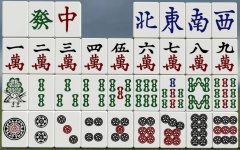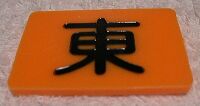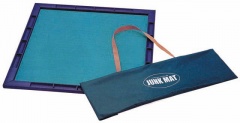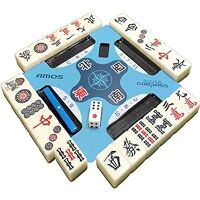Mahjong equipment
A physical game of Japanese mahjong is normally played with a set of 136 tiles, along with a few other pieces of equipment, such as dice and game mats. When playing online, there is no need to consider equipment.
Japanese tiles
Japanese mahjong sets usually come with 144 tiles in a case. Japanese tiles are usually about the size 16 mm x 19 mm x 26 mm (WLH), and are capable of standing on their own. The tiles are often dual colored, with the backs sharing the same color.
136 of the 144 tiles are used for Japanese mahjong itself, leaving 8 tiles left unused:
- 4 red fives: one for manzu and souzu, and two for pinzu. To use these, replace a copy of each of the regular fives with the red fives of the corresponding suit. Games are typically played with 3 red fives, leaving the second red 5p out of the game.
- 4 flower tiles. These may be used as nukidora.
Of the 136 tiles in play, there are 34 unique types of tiles, with 4 copies of each type. The tiles may be subgrouped into further categories:
- Number tiles (27 types): There are three numbered suits - Manzu, Pinzu, Souzu. Each suit has tiles numbered from 1-9. The three numbered suits are mostly identical, but each tile group must be formed with one suit (though a hand can have multiple suits). Number tiles can be used in sequences.
- Honor tiles (7 types): There are two distinct groups of honor tiles. All honor tiles cannot be used in sequences.
- Winds (4 types): East, South, West, North. Wind tiles are unique as their value changes with the round wind and seat wind.
- Dragons (3 types): White (Haku), Green (Hatsu), Red (Chun).
All tiles listed below follow the order used for dora.

Pin
| Ii pin | Ryan pin | San pin | Suu pin | Uu pin | Rou pin | Chii pin | Paa pin | Kyuu pin |
Pinzu 「筒子」, or pin 「筒」 for short (lit. "tubes" or "cylinders"), are commonly called dots or circles in English. The symbols originally represent coins.
Sou
| Ii sou | Ryan sou | San sou | Suu sou | Uu sou | Rou sou | Chii sou | Paa sou | Kyuu sou |
Souzu 「索子」, or sou 「索」 (lit. "strings"), are commonly called bamboo or sticks in English. The symbols originally represent strings with copper coins strung on them.
Ordered 1-9, it is special to note the 1-sou tile which is marked with a large bird instead of 1-stick, to discourage cheating by tile alteration.
Man
| Ii wan | Ryan wan | San wan | Suu wan | Uu wan | Rou wan | Chii wan | Paa wan | Kyuu wan |
Manzu 「萬子」, or man/wan 「萬」 (lit. "ten thousands"), are commonly called characters in English. They originally represent sets of 100 strings with each 100 coins.
Each tile displays two characters. A Chinese character or Japanese kanji are used to indicate the numbers 1-9 on the upper side of each tile. The lower character on each tile means "ten thousand". While some sets have the alphanumeric representations of the numbers superscript on the upper left or right corners, standard Japanese sets lack these alphanumeric superscripts. For such sets, it is best to memorize the kanji for 1-9.
Winds
| Ton | Nan | Shaa | Pei |
Kazehai 「風牌」, or winds, include four types of tiles: East, South, West, and North. The wind tiles correlate to the player seating, and so therefore, it is best to remember the wind tiles in the East, South, West, and North order, as they correspond to the seating order. Likewise, this is significant to note for yakuhai.
Dragons
| Haku | Hatsu | Chun |
Sangenpai 「三元牌」, or dragon tiles in English, consist of white, green, and red. Just noting their color is sufficient for play.
Note that in a lot of physical tile sets, the green dragon 「發」 is printed in black, just like the wind tiles, making it necessary to learn to distinguish it from the wind tiles when playing with those tile sets.
Other tiles
Flowers

Japanese tile sets usually come with a few hanahai or fapai 「花牌」 ("flower tiles"). These are unique tiles with floral designs that are marked with kanji to differentiate them. Their designs are not standardized, so they can look very different between sets. Flower tiles are very rarely used in Japanese mahjong. If they are used, they usually function as nukidora. Rulesets that use them are referred to as hana mahjong 「花麻雀」 ("flower mahjong"). Even more rarely, they may be used as a fifth seat wind in five-player mahjong variants.
Japanese sets usually only include 4 flower tiles which are also called season tiles 「季節牌」. They are marked with kanji for spring 「春」, summer 「夏」, autumn 「秋」, and winter 「冬」.
| Spring | Summer | Autumn | Winter |
In some cases, the four gentlemen 「四君子」 are included in addition to the seasons. They are marked with kanji for plum 「梅」, orchid 「蘭」, chrysanthemum 「菊」, and bamboo 「竹」. These are very rare in Japanese mahjong sets, but standard in Chinese sets.
| Plum | Orchid | Chrysanthemum | Bamboo |
Both in English and in Japanese, the term "flower tiles" may also be used to refer to the four gentlemen exclusively, without including the season tiles.
Tenbou
Tenbou 「点棒」 are the point sticks used to keep track of points. When points are exchanged between players, tenbou are used to facilitate said exchange. Gambling games may tie these point sticks to money.
Chips (e.g. poker chips) or other types of counters may be used instead of tenbou, so long as their values are agreed beforehand.
Dice
Two dice are used to determine the wall break at the start of each hand. In some cases, four dice may be used. Mahjong sets usually come with four dice to accommodate this style, and to provide spares.
Round indicator

A round indicator is used throughout the game to indicate the current wind round, either the East round or South round. It is placed on the right-hand side of a player to also indicate that that player is either the current dealer or the initial dealer, depending on local or house rules. If placed with the initial dealer, the dice are commonly used to indicate the current dealer, as they get passed around from one dealer to the next.
In Japan, round indicators are usually a plastic plate with the kanji for East 「東」 on one side and South 「南」 on the other. In China, it is common to use round indicators that hold special dice with kanji for winds on its sides, which can be removed from the holder and placed back with a different side up.
Playing surfaces

Mahjong tables and mahjong mats are used to provide a softer surface that protects the tiles from wear and tear, and allows them to slide around more easily. They come in various sizes, but they are all square-shaped. Most tables and some mats have slots or drawers to keep point sticks, and a raised border to help with making straight lines of tiles.
Automatic tables
Automatic mahjong tables contain an electronic device that automatically shuffles tiles and builds walls, saving time and effort from the players. They also roll the dice at the push of a button, and can sometimes keep track of points.
Compass

A mahjong compass is an optional piece of equipment that can be placed in the middle of the playing area to indicate seat winds. It can also help align discard tiles, hold dice and riichi bets, and indicate which die roll corresponds to which side when breaking the wall. It is usually removed when shuffling tiles, and placed back with the east side facing the dealer after building the wall.
A compass can be useful for beginners. Instead of buying one, it's easy to make a simple compass from paper or cardboard.
Yakitori marker

Japanese mahjong sets may come with 4 yakitori markers, which can be used to aid in playing with the yakitori rule variant, where players get a penalty if they haven't won any round (kyoku) by the end of a game (hanchan). If used, each player places one marker face up at the start of the game, and turns it face down if they win a round.
Playing cards
Mahjong playing cards are an alternative medium to play the game, where cards are used in place of tiles. They are considerably cheaper than mahjong tiles, but tiles are considered the standard way to play, since playing cards are more cumbersome to use.